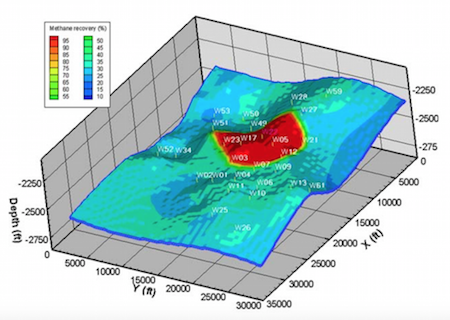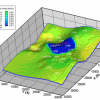SIMEDWin
SIMEDWin is a coal seam methane reservoir simulator, which can be used to investigate the relationships between reservoir properties, well operating procedures and gas production. SIMEDWin is used to optimise well field design, reservoir management and production forecasting.
Capabilities
SIMEDWin is the windows user interface version of SIMED II, which was originally developed by Val Pinczewski and Mark Stevenson, School of Petroleum Engineering, University of New South Wales.
SIMEDWin is primarily designed for modelling the drainage of gas from coal seams but it can also be used to model conventional dry gas reservoirs. It is ideally suited for modelling coal seam methane production and is capable of single well or full field simulations, which involve multiple wells with multiple completions.
It has seen extensive use since the early 1990s for both coal seam methane and gas management in coal mines. It has been thoroughly tested through comparison with other industry simulators and field data.
SIMEDWin is appropriate for simulating reservoirs which involve:
- two phase (gas and water) flow
- three dimensional geometry
- multi-component (multiple gas species) adsorption and gas migration
- single or dual porosity reservoirs
Features
SIMEDWin incorporates a number of advanced functions, which makes the software ideal for use in the coal seam methane and mining industries. Some significant features of SIMEDWin include:
Model processes
- Dual porosity (Warren-Root)
- Permeability – various options (2 x stress permeability models, multi- component matrix shrinkage effects (modified Sawyer model), klinkenberg correction)
- Multi-component adsorption (extended Langmuir, Ideal Adsorbed Solution)
- Fully coupled implicit well model
- Phase behaviour internally defined for common gas species (methane, carbon dioxide, nitrogen, ethane); ability for the user to define gases (Peng-Robinson EOS)
Input options
- Multiple coal types
- Several initialisation options • Variable gridding
- Hydraulic fracture model
- Face drainage option (for coal mining)
- Longhole drainage
- Grid block and well numbers limited by memory
Other considerations
- Fully implicit formulation
- Klinkenberg effect correction factor
- Flow dependent skin factor
- Numerical dispersion control
- Jacobian optimisation/inversion
- Comprehensive input data error checking
- Windows user interface and post processing
- Automated history matching using Marquardt’s
Coal seam methane reservoirs are generally ‘tight’, having low permeabilities compared to conventional petroleum reservoirs.
The gas drainage process within coal differs




